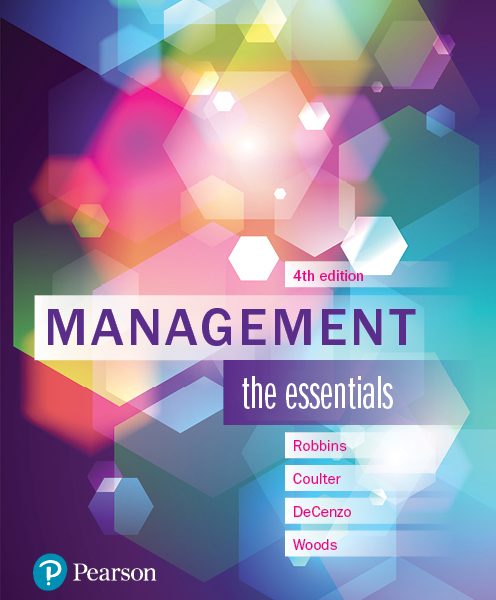Test Bank for Management The Essentials 4th AUS Edition by Robbins

Product details:
- ISBN-10 : 148861654X
- ISBN-13 : 978-1488616549
- Author: Stephen Robbins Mary Coulter David, A. De Cenzo Megan Woods
Management: The Essentials has been written using concise and straightforward language so that students can spend more time learning the theory instead of deciphering the language. Complementing this, concepts are presented in a variety of ways to create visual interest. Three key principles underpin the development of this text: To show students how understanding management will be relevant and valuable to them. To make this textbook accessible and engaging so it is easier for students to learn. To provide concise coverage of essential management principles, theories and practices.
Table contents:
- Chapter 1 Managers and management
- Who are managers, and where do they work?
- What four characteristics do all organisations share?
- How are managers different from non-managerial employees?
- What titles do managers have?
- From the past to the present: 1588-1705-1911-Today
- What is management?
- What do managers do?
- What are the four management functions?
- What are management roles?
- What characteristics do managers need?
- Is the manager’s job universal?
- Why study management?
- A question of ethics
- What factors are reshaping and redefining management?
- Why are customers important to the manager’s job?
- Why is innovation important to the manager’s job?
- Why are ethics and social responsibility important to the manager’s job?
- Why are social media tools important to the manager’s job?
- Why is sustainability important to the manager’s job?
- Managing for sustainability | Making a positive impact
- Review
- Chapter summary
- Discussion questions
- Management skill builder | Becoming politically adept
- Case application 1—Google: Building a better boss
- Case application 2—Managing to create a better world
- Endnotes
- History module A brief history of management’s roots
- Early management (3000 BCE-1776)
- Behavioural approach (late 1700s-1950s)
- Classical approaches (1911-1947)
- Quantitative approach (1940s-1950s)
- Contemporary approaches (1960s-present)
- Choosing between management approaches
- Endnotes
- Chapter 2 The managerial environment
- What is the external environment of an organisation?
- What is the general environment of an organisation?
- What is the specific environment of an organisation?
- Managing for sustainability | Connecting up to do more with less
- How does the external environment affect managers?
- From the past to the present: 1981-1987-1991-today
- What is organisational culture, and why is it important?
- A question of ethics
- How does organisational culture affect managers?
- Managing for diversity |The paradox of diversity
- Review
- Chapter summary
- Discussion questions
- Management skill builder | Understanding culture
- Case application 1—Tragedy in fashion
- Case application 2—Getting a boost
- Endnotes
- Ethics and social responsibility module Managing socially responsible and ethical behaviour
- How do organisations define their social responsibilities?
- Should organisations be socially responsible?
- How can managers identify the ethical thing to do?
- What factors influence ethical and unethical behaviour?
- How can managers encourage ethical behaviour?
- Endnotes
- Chapter 3 Foundations of decision making
- How do managers make decisions?
- What defines a decision problem?
- What is relevant in the decision-making process?
- How does the decision maker weight the criteria and analyse alternatives?
- What determines the best choice?
- What happens in decision implementation?
- What is the last step in the decision process?
- Managing for sustainability | Deciding how to ‘go green’
- What common errors are committed in the decision-making process?
- What are the three approaches managers can use to make decisions?
- What is the rational model of decision making?
- From the past to the present: 1945–1978–today
- A question of ethics
- What is bounded rationality?
- What role does intuition play in managerial decision making?
- What types of decisions and decision-making conditions do managers face?
- How do problems differ?
- How does a manager make programmed decisions?
- How do non-programmed decisions differ from programmed decisions?
- How are problems, types of decisions and organisational level integrated?
- What decision-making conditions do managers face?
- How do groups make decisions?
- What are the advantages and disadvantages of group decision making?
- Managing for diversity | The value of diversity in decision making
- When are groups most effective?
- How can you improve group decision making?
- What contemporary decision-making issues do managers face?
- How does national culture affect managers’ decision making?
- Why are creativity and design thinking important in decision making?
- Review
- Chapter summary
- Discussion questions
- Management skill builder | Being a creative decision maker
- Case application 1—Going greener
- Case application 2—Dramatic decisions
- Endnotes
- Chapter 4 Foundations of planning
- What is planning, and why do managers need to plan?
- Why should managers formally plan?
- What are some criticisms of formal planning, and how should managers respond?
- Managing for sustainability | Planning for a more sustainable future
- Does formal planning improve organisational performance?
- What do managers need to know about strategic management?
- What is strategic management?
- Why is strategic management important?
- What are the steps in the strategic management process?
- What strategic weapons do managers have?
- How do managers set goals and develop plans?
- What types of goals do organisations have, and how do they set those goals?
- From the past to the present: 1954-1960s and 1970s-today
- What types of plans do managers use, and how do they develop those plans?
- Managing for diversity | Planning for workforce diversity
- What are some popular planning tools?
- What contemporary planning issues do managers face?
- How can managers plan effectively in dynamic environments?
- How can managers use environmental scanning?
- A question of ethics
- How can managers use benchmarking?
- Review
- Chapter summary
- Discussion questions
- Management skill builder | Being a good goal setter
- Case application 1—Less is more
- Case application 2—Spy games
- Endnotes
- Chapter 5 Organisational structure and design
- What are the six key elements in organisational design?
- What is work specialisation?
- What is departmentalisation?
- What are authority and responsibility?
- What is span of control?
- A question of ethics
- How do centralisation and decentralisation differ?
- What is formalisation?
- How is a mechanistic organisation different from an organic organisation?
- What contingency factors affect structural choice?
- How does strategy affect structure?
- How does size affect structure?
- How does culture influence structure?
- How does technology affect structure?
- How does the environment affect structure?
- From the past to the present: 1965-1967-1984-Today
- What are some common organisational designs?
- What traditional organisational designs can managers use?
- Managing for sustainability | Structure and sustainability
- What contemporary organisational designs can managers use?
- Managing for diversity | Sourcing diversity
- What are today’s organisational design challenges?
- How do you keep employees connected?
- How do you delegate effectively?
- How do global differences affect organisational structure?
- How do you build a learning organisation?
- How can managers design efficient and effective flexible work arrangements?
- Review
- Chapter summary
- Discussion questions
- Management skill builder | Increasing your power
- Case application 1—Structural renewal at the Australian Red Cross
- Case application 2—Shortening the corporate ladder
- Endnotes
- Chapter 6 Managing human resources
- What is the human resource management process, and what influences it?
- What is the legal environment of HRM?
- From the past to the present: 1913-today
- How do managers identify and select competent employees?
- What is employment planning?
- How do managers reduce their workforce?
- How do organisations recruit employees?
- How do managers select job applicants?
- How are employees provided with needed skills and knowledge?
- How are new employees introduced to the organisation?
- What is employee training?
- How do organisations provide a safe working environment?
- A question of ethics
- How do organisations retain competent, high-performing employees?
- What is a performance management system?
- What happens if an employee’s performance isn’t up to par?
- How are employees compensated?
- Managing for sustainability | Sustainable HRM
- What contemporary HRM issues do managers face?
- How can managers manage downsizing?
- How can workforce diversity be managed?
- Managing for diversity | Mentoring and discrimination
- What is sexual harassment?
- What is career development?
- Review
- Chapter summary
- Discussion questions
- Management skill builder | Providing good feedback
- Case application 1—Managing diversity at PwC
- Case application 2—Producing CHAMPS at KFC
- Endnotes
- Chapter 7 Managing change and innovation
- How can managers encourage innovation in an organisation?
- How are creativity and innovation related?
- How can organisations stimulate creativity?
- What’s involved in turning creativity into innovation?
- How can a manager foster innovation?
- How does design thinking influence innovation?
- Managing for diversity | Listening to everyone
- What is change, and how do managers deal with it?
- Why do organisations need to change?
- Who initiates organisational change?
- How does organisational change happen?
- From the past to the present: 1943-1944-1947-today
- Managing for sustainability | Embedding sustainability in organisational thinking
- Reasons why change fails
- What are some techniques for overcoming barriers to organisational change?
- What reaction do employees have to organisational change?
- What is stress?
- What are the symptoms of stress?
- What causes stress?
- How can stress be reduced?
- A question of ethics
- Review
- Chapter summary
- Discussion questions
- Management skill builder | Stress management
- Case application 1—Turning Coles around
- Case application 2—Saving mates
- Endnotes
- Chapter 8 Foundations of individual behaviour
- What are the focus and goals of organisational behaviour?
- What is the focus of OB?
- What are the goals of organisational behaviour?
- What role do attitudes play in job performance?
- What are the three components of an attitude?
- What attitudes might employees hold?
- Do individuals’ attitudes and behaviours need to be consistent?
- What is cognitive dissonance theory?
- How can an understanding of attitudes help managers be more effective?
- Managing for sustainability | Translating good intentions into action
- What do managers need to know about personality?
- How can we best describe personality?
- A question of ethics
- Can personality traits predict practical work-related behaviours?
- How do we match personalities and jobs?
- Do personality attributes differ across cultures?
- How can an understanding of personality help managers be more effective?
- What is perception, and what factors influence it?
- What influences perception?
- How do managers judge employees?
- How can an understanding of perception help managers be more effective?
- Managing for diversity | Checking assumptions
- How do learning theories explain behaviour?
- What is operant conditioning?
- What is social learning theory?
- From the past to the present: 1927-1971-today
- How can managers shape behaviour?
- How can an understanding of learning help managers be more effective?
- What contemporary OB issues do managers face?
- How do generational differences affect the workplace?
- How do ability, disability and mental health affect the workplace?
- How do managers deal with bullying in the workplace?
- Review
- Chapter summary
People also search:
management the essentials 4th edition
management the essentials 4th edition pdf free
what are the essentials of management
fourth function of management
essentials of health information management 4th edition
management skills 4th edition





